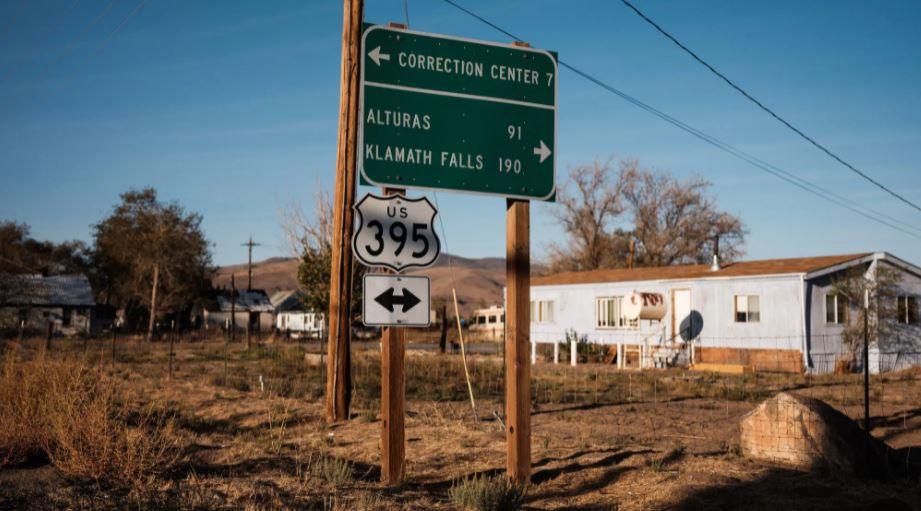After a decade of efforts that sharply reduced inmate populations, California is closing prisons. One town high in the Sierra Nevada whose economy is built on incarceration is waging a legal battle to keep a prison open.
Susanville, Calif., is poised to lose a significant part of its economy if the state closes the California Correctional Center, a major employer for the community.Credit…Max Whittaker for The New York Times
SUSANVILLE, Calif. — The Mauldin family loved their house. They bought it during the financial crisis and spent a lot of money to upgrade the tan, farmhouse-style home. New landscaping and fencing so the two kids would have a nice place to play. An entirely new kitchen and new floors. Rows of lilac bushes lining the driveway. But when word came down last spring that a prison in the town of Susanville would close, the family made a decision they never wanted to make: They put their home up for sale.
“We put our heart and soul into this house and this area,” said Jessica Mauldin, 39, whose husband works as a prison guard. “We have built our village here.”
In Susanville, at the edge of a valley hemmed in by the Sierra Nevada in remote northeast California, there are nearly as many people living inside the walls of the town’s two state prisons, roughly 7,000 people, as outside. About half of the adults work at the prisons — the soon-to-be shuttered minimal security California Correctional Center and a maximum security facility, High Desert, which will remain open.


The story of Susanville is not unlike that of countless rural communities in America that in the back half of the last century welcomed correctional facilities to replace dying industries at a time when the country was undergoing a prison-building boom. But now, California and other states are moving to reduce inmate populations and close prisons amid a national movement to address racial disparities in the criminal justice system.
“It will affect the whole town,” said Mendy Schuster, Susanville’s mayor, whose husband works as a corrections officer. “I don’t want to imagine what it would be like.”
With so much at stake, Susanville is fighting back, trying to halt the closure through legal means, rather than seeking out new industries to replace the prison. Last year, the town filed a lawsuit against the state that is still pending, arguing that officials violated environmental codes in deciding to close the prison and did not give local officials any prior notice.

Image

It’s a trend playing out in other states too, especially in New York, where the inmate population is at its lowest level in decades. After former governor Andrew M. Cuomo announced a slate of prison closures, a backlash erupted upstate that was similar to what has unfolded in Susanville, with protests over job losses. More recently, New York’s current governor, Kathy Hochul, said she planned to close six prisons, which drew condemnation from Republican officials who said the move would make the public less safe and cost too many jobs.
On Main Street in Susanville, “Save our rural communities,” reads the sign that greets breakfast customers at the Courthouse Cafe. The street connects the city’s past and present: On one end sits the cluster of Old West-style buildings of the historic center, and on the other, the sprawl of fast food outlets and big box retailers.
“We have it good,” said Kerri Cobb, a local mortgage broker, about the prison. She has organized fund-raising for the lawsuit. “That’s why we’re fighting to keep it. These facilities gave us the ability to rise up. And now they are pulling the rug out from under us.”
On a brisk late-fall evening, Ms. Cobb huddled with a group of public officials and prison workers at a pizzeria. As a waitress came in and out, carrying pizzas and beers, Ms. Cobb ran down the fund-raising: $7,700 so far, mostly from small donations.
Still, late last year, a going-out-of-business sign appeared on one of the storefronts on Main Street, Uptown Uniforms, which for years has sold work shirts and pants to police officers, firefighters and construction crew.


It was the first tangible signal of the economic fallout that residents have been bracing for. Not far away from Uptown Uniforms is the century-old Morning Glory Dairy, one of the businesses in town that sell directly to the prison — hundreds of thousands of dollars a year of milk, eggs and ice.
Josh McKernan, 32, who bought the dairy a few years ago, said he believes his business can survive, but it will be smaller and he may have to lay off some workers. “I’m trying to provide for my kids like everyone else,” he said. “If it wasn’t for this I’d probably be working in the prison. There’s not much else.”
‘The Nation’s Newest Concept in Correction’
It was 1963, and it was July. The governor of California, Edmund G. Brown, had come to Susanville to showcase, as a reporter on the scene put it, “the nation’s newest concept in correction.”
This was years before the era of mass incarceration in America, and California believed it had a new concept for dealing with lawbreakers: redemption through hard work and connection with nature. Among the green forests and pristine mountain air, inmates wearing blue shirts and bluejeans would learn to battle wildfires, domesticate wild horses and clear trees for hiking trails.
Susanville’s transformation was underway.
“When the prison started, there was just so much growth,” said Susan Couso, who moved here as a schoolgirl in 1962. “Everyone was excited. Before the prisons, after high school young men would either go work in the sawmills or go elsewhere.”

Image

On a recent morning, Ms. Couso, a retired schoolteacher who is married to a former prison guard, could be found at the Lassen Historical Museum, where she volunteers and which displays artifacts of the state’s settler history.
Ms. Couso pulled from a shelf an essay she wrote for the Lassen County Historical Society about the economic boom that followed the opening of the prison in the 1960s:
“Now, houses were to be built to accommodate the new employees. Teachers needed to be hired, stores prepared to expand, and almost every facet of the economy was set to take off.”
Perhaps inevitably, then, the plans to close the prison have become political. Most of the town’s leaders say they believe the plans are a vendetta from Mr. Newsom to punish them for their conservative politics, rather than the fruition of efforts over many years to change the criminal justice system, some approved by voters through ballot measures.
“It’s hard not to think of it as some vindictive measure from the governor,” said Jarret Ellena, a fourth generation Susanville resident whose family has real estate holdings, including motels that rely in part on business from families traveling from across California to visit incarcerated relatives.
Image

Image

Susanville flourished in recent decades during a rise in prisoner populations caused in part by punitive measures like three-strikes laws that disproportionately sent Black people to prison. Many of those filling up prison beds were convicted and sentenced by juries and judges in liberal cities like Los Angeles and San Francisco but sent to rural, conservative places like Susanville to serve their sentences.
The state’s prisons became so overcrowded that the Supreme Court intervened in 2011 and ordered them depopulated, ruling that the lack of medical care and adequate food and sanitation violated the Eighth Amendment’s ban on cruel and unusual punishment.
The announcement that California would close two prisons was hailed as a milestone by activists, the culmination of years of new sentencing laws and the work of liberal prosecutors that sharply reduced the number of people in prisons across the state. At their most crowded, California prisons housed more than 160,000 people. Today, they hold just under 100,000.
The decline in the state’s inmate population that was fueled by the pandemic, as officials ordered early releases for thousands of prisoners to contain the virus, and by changes to California’s sentencing laws in recent years that were approved directly by voters through ballot measures, has allowed Mr. Newsom to fulfill a promise to start closing prisons.
Brian Kaneda, an activist in Los Angeles who has organized campaigns to close prisons, said he believes the state has a “moral and ethical obligation” to help communities like Susanville invest in new jobs to replace the ones in prisons. “No one dreams of being a prison guard,” said Mr. Kaneda, the deputy director of Californians United for a Responsible Budget, which has campaigned for California to spend less on prisons. “It’s because they have no option.”

Image

Top salaries for prison guards can approach six figures, but the work can be traumatizing, with violence a constant threat.
“It’s a hugely dysfunctional place,” said Randall Wagner, 72, a retired corrections officer in Susanville. “People in the general public have no idea what it’s like.”
He continued, “Susanville is described as a ‘happy little prison town’ that has created a pastoral life for many of its residents. I had a different experience.”
At times during the meeting at the pizzeria, residents pushed back on a narrative circulating on social media that Susanville is a white community fighting to maintain a prosperity built largely on incarcerating people of color.
“People have pegged us as this white community that just wants to keep incarceration going,” Ms. Cobb said. “This industry was given to us and we embraced it.”
Trevor Albertson, the president of Lassen Community College in Susanville, is one of the few leaders in the community who sees a silver lining in losing the prison, even as the school’s business will be affected: The college will lose about 200 enrollments, or 15 percent of its total, with the loss of programs it runs inside the prison.
“Who wants to hang their hat on the fact we have a prison?” he said.
In conversations with local officials, he said, this has been his message.
The town should welcome the opportunity to diversify so that “we’re not just shunting people off to work in the prison,” he said. “Why are we not celebrating that?”
“What now?” Ms. Mauldin said. “We don’t know what’s going to happen and we don’t know what our next step is.”
As to Susanville’s future, she said, “Nothing will be the same.”

Tim Arango is a Los Angeles correspondent. Before moving to California, he spent seven years as Baghdad bureau chief and also reported on Turkey. He joined The Times in 2007 as a media reporter. @tarangoNYT


